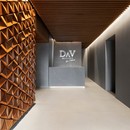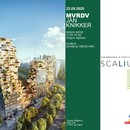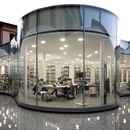Biography
After graduating in Florence, the career of Andrea Maffei (born in Modena in 1968) began with Massimo Carmassi in Pisa and continued in Tokyo, from 1997 to 2004, at the studio of Arata Isozaki.He was initially part of the team for the Ceramic Museum in Gifu (Japan) and then was head of the project for the competition to design the New Exit of the Uffizi Gallery. With its aim of expanding the exhibition space, improving the user experience and creating a new exit from the gallery, the project for this great stone and steel loggia is one of Isozaki and Maffei’s most important partnerships.
Maffei has also had important professional experience in Asia and the Middle East, in his role as head architect on the Al Wabrah Villa of Sheik Al-Thani in Doha, Qatar (1999-2001) and on the extension of Qatar’s History Museum.
He becomes an associate of Arata Isozaki and responsible for Italian projects.
Maffei has worked on a range of different buildings, heading the design of the Turin Ice Hockey Stadium for the Winter Olympics 2006 (also known as the Palaisozaki), which was designed from the very beginning with the aim of creating a multifunctional space after the Olympics, to host concerts, conferences and various other events.
At the same time, he was head of the project for the Olympic Swimming Pool and Park at Piazza d’Armi in Turin (2002-2006).
In 2005, he founded the studio that bears his name, Andrea Maffei Architects, in Brera (Milan) and developed various projects in Italy and abroad, some of which won important competitions both in Italy and internationally. He has designed several sports stadia, including rebuilding the Filadelfia in Turin (2012), the new National Olympic Stadium in Tokyo (2012) and the Chorzow Stadium in Poland (2013).
His ongoing partnership with Isozaki has been extremely fruitful and has included designs for the new station in Bologna (2008), the new headquarters of the Province of Bergamo (2009), and the project to extend the city of Monte Carlo by the sea (2007-2008), aimed at "extending the city over the sea to create a new peninsula with homes, hotels, museums and offices".
The first project completed by the Isozaki-Maffei studios was the new Library of Maranello (2011). In a unique urban setting, an old industrial building with a shed covering, surrounded by private homes on three sides, the building maintains the existing perimeter walls towards the houses, transforming them into green walls covered by climbing plants – a kind of "parallel world that can’t be seen from outside, but which one gradually discovers and experiences, surrounded by greenery and water".
Some of the most famous works with Isozaki include the Allianz Tower in the ex-trade fair area of the CityLife redevelopment in Milan (2015). Starting from a cosmopolitan vision of Lombardy’s capital, the nerve centre of contemporary Italian architecture, Isozaki and Maffei developed "the idea of a kind of endless tower" whose aim is "the maximum verticality and tension towards the sky, not limited by a finished, completed form, but using a modular system that can replicate itself to infinity seamlessly". The result was a skyscraper (also known as the Isozaki Tower) 209 metres high that is the building in Italy with the largest number of floors (50).
As well as his work as an architect, since 1997 Maffei has also been a journalist for the “Casabella”, architecture magazine, in which he focuses on designs and texts on contemporary Japanese architecture. He is also the author of the monograph, “Toyo Ito, le opere, i progetti, gli scritti” (“Toyo Ito, Works, Projects, Writings”) published by Electa in 2001.
His academic activity includes the role of visiting professor of architectural design at Waseda University, Tokyo (2000-2002) and he holds conferences and talks on architecture.
Andrea Maffei Architects: major works and designs
- Qingdao West Coast New District Central Vitality Economic Centre (design), Qingdao (China), 2018
- Enlargement and development of Casablanca Town Centre (design), Casablanca (Morocco), 2017
- New Oratory of Santa Maria Assunta (design), Reggio Emilia (Italy), 2016
- Great Azerbaijan Square (design), Tabriz (Iran), 2016
- Allianz Tower (with Arata Isozaki), Milan (Italy), 2015
- Florim Flagship Store, Milan (Italy), 2015
- Chorzow Stadium (design), (Poland), 2013
- MABIC – the New Library of Maranello (with Arata Isozaki), 2011
- Ice Hockey Stadium for the Turin Winter Olympics (Italy), 2006
- Piazza D’Armi Park, Turin (Italy), 2006
- Olympic Swimming Pool, Turin (Italy), 2006
- New Exit of the Uffizi Gallery (with Arata Isozaki), Florence (Italy), 1999-ongoing
Official website
www.amarchitects.it
Interview
Maranello Library is the first project by Arata Isozaki & Andrea Maffei Associati to be built. Can you tell us how you and the great Japanese master work together?Andrea Maffei: Isozaki and I have been friends who work together for more than ten years, and so we have a very close relationship. When we start work on a new project we’re in Tokyo, or somewhere else in the world, and we discuss the theme, the design concept. We start with the building’s functions and their dimensions. We never start with form, but always with the client’s requirements and the type of design that would work in the best possible way in this context. We’re not interested in creating form for its own sake and then filling it with functions; on the contrary, we start with the functions and the history of this type of building over the years in our attempt to determine the significance it might have today. The result is a number of concepts which are then assessed on the basis of studio models and computer simulations, and we choose the best solution. Then our studio in Milan develops the details of the project and we discuss the choices made and the finishing touches on the project with the client.
The dialogue between architects directs different ideas and experiments in a single direction.
The whiteness of the structures, furnishings and floors, the green walls of ivy surrounding the building and the transparencies created through the water seem to be the key ingredients in this project. What scenario is the project attempting to create?
Andrea Maffei: The concept centred on an old industrial building, with a shed roof, surrounded by private homes on three sides, and the relationship with the building’s context was delicate. We thought the best thing would be to preserve the existing walls around the perimeter on the side where the homes are, transforming them into green walls covered with vines and opening up the building’s wrapper on the side facing the municipal offices. The new building has an organic form which is lower than the walls so that it cannot be seen by the neighbours through their windows, and there is no invasion of privacy. We wanted to create a parallel world that could not be seen from the outside, but that would be discovered a little at a time, and that has a life of its own, surrounded by greenery and water. It’s like discovering a wonderful secret garden in the inner courtyard of an old building.
How is space distributed in the open space? What strategies do you use to represent the different functions?
Andrea Maffei: The open space is the best kind of arrangement for a reading room where readers can help themselves to the books. It permits distribution of the tables in the best possible way, and makes room for more of them, as there are no internal walls, just one big open space. This layout is the most common type in the big libraries such as the British Library in London. In our case, the open space of the reading room occupies the entire ground floor. Seeing as we had decided to transform the router walls of the old building into green walls, we built the entire perimeter of the library out of glass so that readers could enjoy the view of the greenery as they read or study. And we surrounded the library with a pool of shallow water to add another natural element to the poetry of the space. The glass is curved all along the perimeter to echo the movement of the water and the green leaves. This solution makes what could have been an ordinary box into a natural environment that will fascinate citizens and invite them to use it more frequently to enjoy this inner garden. We created another open space on the underground floor for exhibitions and presentations, a big rectangular space with no partitions, with track lighting that may be oriented in any direction. This flexibility makes the space suitable for hosting exhibitions, meetings and presentations. The ceiling is sound-absorbing to improve acoustic performance.
The City of Maranello has said it believes in the need to promote innovative projects for the city aimed at qualifying urban space through attractive architecture. Is the library part of this programme?
Andrea Maffei: Of course: the library is one of the projects the City wanted to work on to improve the quality of the city and its services with innovative buildings. Ferrari had its workshops in Maranello designed by archistars to improve the quality of the factory, but they’re not open to the public. And so the city wanted to extend this concept to public buildings open to all, to improve the town’s quality of life and renew its architecture. Our project and Piero Lissoni’s welcome tower are stimuli that renew their context and make it into an attraction for the community.
Work will soon begin on the Endless Tower, the CityLife skyscraper with which Arata Isozaki & Andrea Maffei Associati are contributing to the redevelopment of Milan’s historic trade fair district. What formal and technological innovations characterise this building?
Andrea Maffei: The concept behind the Citylife skyscraper was reinterpreting the very idea of the skyscraper. These buildings are normally designed with a central core for services (elevators, ventilation spaces and fire stairs) with the offices arranged around them. In our project, we wanted to experiment with a different form of distribution: the core was divided in two parts positioned at either end of the rectangular surface. This created a big rectangular open space in the middle of the building, with panoramic elevators at both ends. This layout makes the offices more efficient, as a single big space in which the occupants can easily and freely organise their offices. Freedom and flexibility of use seem to be the most interesting aspect of the building, in our opinion. This basic functional distribution was then developed vertically on the basis of a concept of modularity which may be repeated infinitely. We did not want to create a skyscraper that ends with a head closing it off, but to characterise it with a series of clear, differentiated compositional modules that are constantly overlapped vertically, in theory infinitely, like a sort of endless tower. We created modules of 6 floors characterised by a slightly curved façade that distinguishes among them, not only for formal reasons but to represent our concept and make it visible. This is the language the architect uses to represent the concept he wishes to express. The floors in the building are interrupted by two technical levels, one halfway up the building and one at the top, clearly identified by a different façade, picking up on the theme of the entrance lobby. The architectural idiom represents the building’s composition and allows us to understand its functional and technical composition. This is why there are four steel struts on the outside reinforcing the building at its base, so that the core walls can be made thinner for one third of the building’s height. This made it possible to reduce the building’s overall width, saving on façade materials and improving efficiency. Leaving these mechanical aspects bare, such as the struts and panoramic elevators, is an idea inspired by the Futurist movement of the '30s in Milan: the building as machine, in which people’s vertical movements are visible and the gears in the structural mechanism are revealed. In this sense it is a homage to the city of Milan and its futurist artists.
The project is very ambitious, especially if we consider the scenario it fits into, in Italy. Can you tell us how you are planning to manage the various phases in construction? What sort of time span are you looking at?
Andrea Maffei: Construction will begin in June with foundations and continue with the underground parking lot starting in September. We will starting building the above-ground structures in 2012 and work will be completed in January 2015, before the ’EXPO’ scheduled for the summer of the same year. Citylife construction is proceeding actively and on schedule. The client clearly intends to complete the work by the scheduled deadline. The visitors who come to ’EXPO’ will find a new Milan, and these new skyscrapers make a big contribution to the new look of the Lombard city.
Interview by Flores Zanchi
Related Articles: Andrea Maffei Architects
Related Articles










